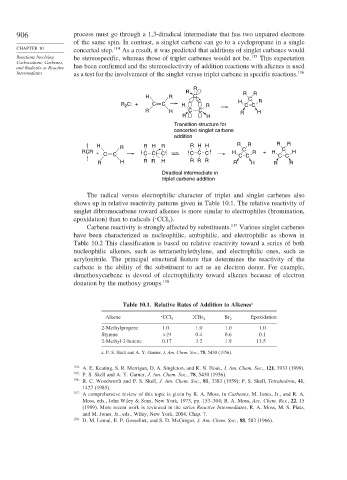Page 930 - Advanced Organic Chemistry Part B - Reactions & Synthesis
P. 930
906 process must go through a 1,3-diradical intermediate that has two unpaired electrons
of the same spin. In contrast, a singlet carbene can go to a cyclopropane in a single
CHAPTER 10 concerted step. 114 As a result, it was predicted that additions of singlet carbenes would
Reactions Involving be stereospecific, whereas those of triplet carbenes would not be. 115 This expectation
Carbocations, Carbenes,
and Radicals as Reactive has been confirmed and the stereoselectivity of addition reactions with alkenes is used
Intermediates as a test for the involvement of the singlet versus triplet carbene in specific reactions. 116
R
R R R
H R C
: H C R
R C: + C C H R C C
2
R H C C R H
R H
Transition structure for
concerted singlet carbene
addition
H R R H R R H H R R R R
RCR + C C C H C R + H C H
C C C C C C C C C
R H R R H R RR R H R R
Diradical intermediate in
triplet carbene addition
The radical versus electrophilic character of triplet and singlet carbenes also
shows up in relative reactivity patterns given in Table 10.1. The relative reactivity of
singlet dibromocarbene toward alkenes is more similar to electrophiles (bromination,
.
epoxidation) than to radicals ( CCl .
3
Carbene reactivity is strongly affected by substituents. 117 Various singlet carbenes
have been characterized as nucleophilic, ambiphilic, and electrophilic as shown in
Table 10.2 This classification is based on relative reactivity toward a series of both
nucleophilic alkenes, such as tetramethylethylene, and electrophilic ones, such as
acrylonitrile. The principal structural feature that determines the reactivity of the
carbene is the ability of the substituent to act as an electron donor. For example,
dimethoxycarbene is devoid of electrophilicity toward alkenes because of electron
donation by the methoxy groups. 118
Table 10.1. Relative Rates of Addition to Alkenes a
.
Alkene CCl 3 :CBr 2 Br 2 Epoxidation
2-Methylpropene 1 0 1 0 1 0 1 0
Styrene >19 0 4 0 6 0 1
2-Methyl-2-butene 0 17 3 2 1 9 13 5
a. P. S. Skell and A. Y. Garner, J. Am. Chem. Soc., 78, 5430 (1956).
114 A. E. Keating, S. R. Merrigan, D. A. Singleton, and K. N. Houk, J. Am. Chem. Soc., 121, 3933 (1999).
115 P. S. Skell and A. Y. Garner, J. Am. Chem. Soc., 78, 5430 (1956).
116
R. C. Woodworth and P. S. Skell, J. Am. Chem. Soc., 81, 3383 (1959); P. S. Skell, Tetrahedron, 41,
1427 (1985).
117 A comprehensive review of this topic is given by R. A. Moss, in Carbenes, M. Jones, Jr., and R. A.
Moss, eds., John Wiley & Sons, New York, 1973, pp. 153–304; R. A. Moss, Acc. Chem. Res., 22,15
(1989). More recent work is reviewed in the series Reactive Intermediates, R. A. Moss, M. S. Platz,
and M. Jones, Jr., eds., Wiley, New York, 2004, Chap. 7.
118
D. M. Lemal, E. P. Gosselink, and S. D. McGregor, J. Am. Chem. Soc., 88, 582 (1966).

